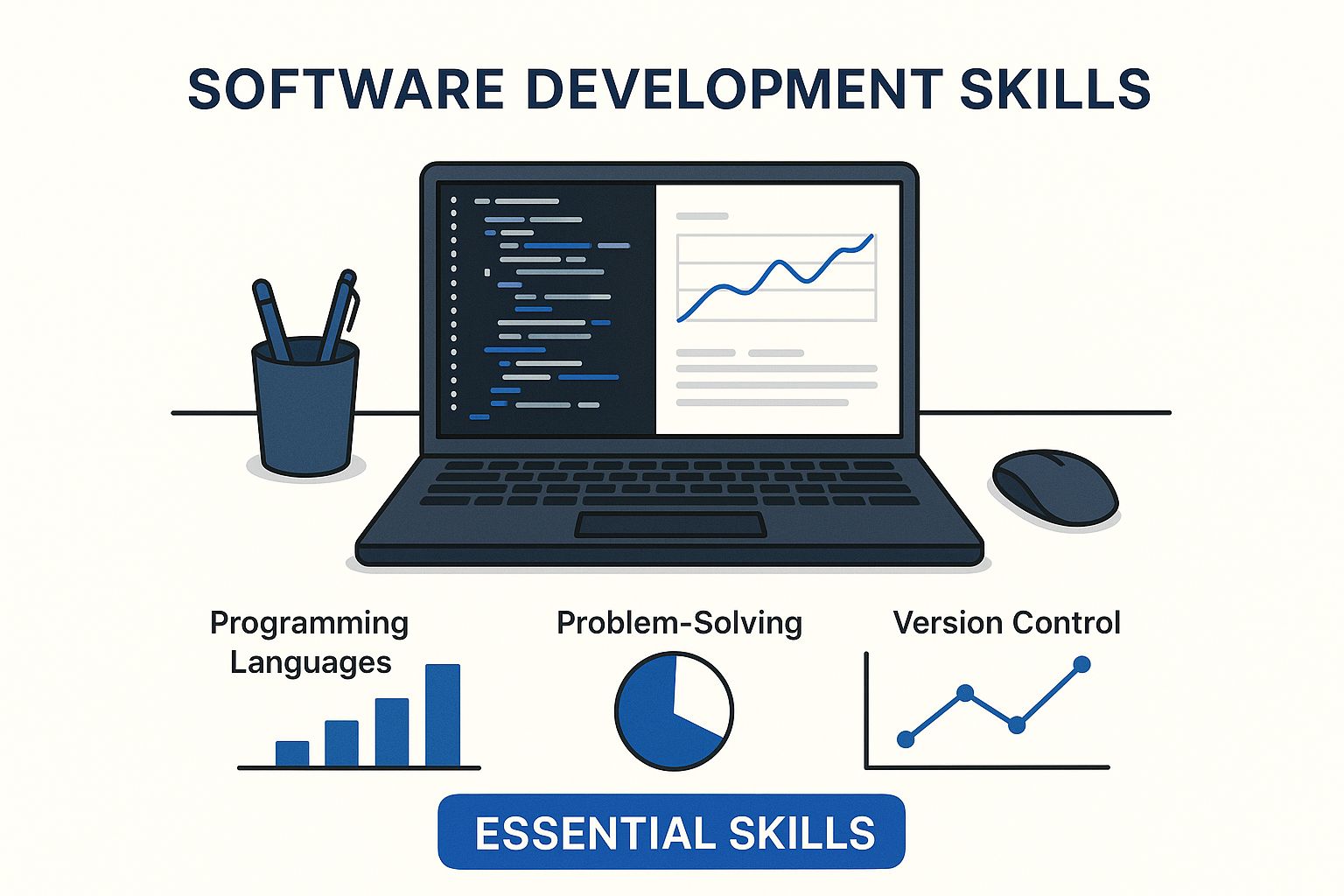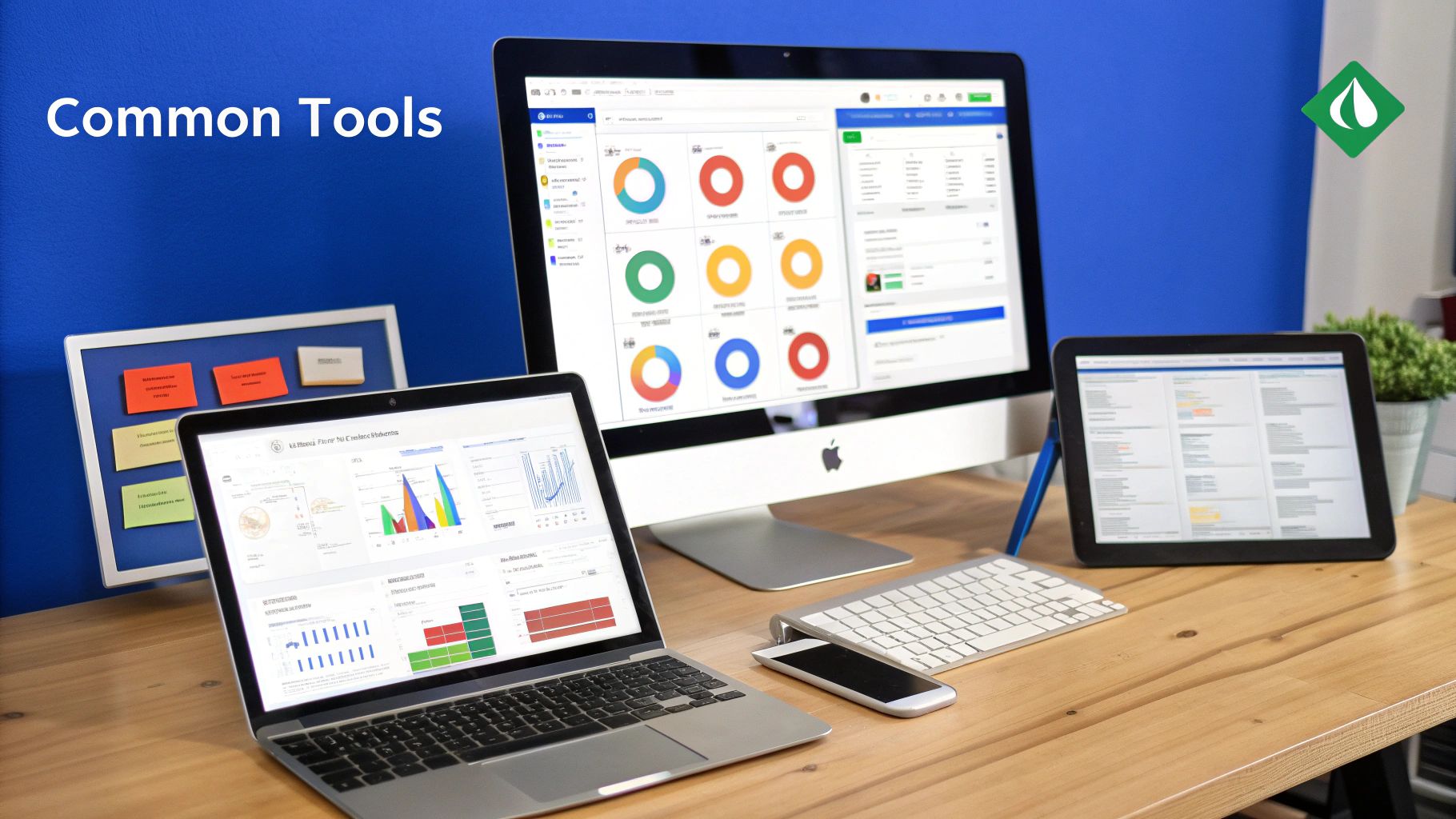The fundamental difference really boils down to this: a data analyst lives in the data, working to figure out the 'what' and the 'why' behind trends. A business analyst, on the other hand, takes those findings and defines the 'how'—how the business can use that information to improve its processes and hit its targets.
Unpacking the Core Differences
At their heart, the roles of data analyst and business analyst are two sides of the same coin, both crucial for pushing an organisation forward. While both deal with data, their day-to-day work and ultimate goals are quite different.
The data analyst is the technical expert, the one with their hands deep in databases, statistical software, and complex visualisation tools. Their job is to sift through enormous, often messy, datasets and translate them into a clear story. Think of them as the detectives of the data world, using clues from numbers to explain what's happened and what might happen next.
A data analyst’s day often involves:
- Data Mining: Pulling raw information from various company systems and external sources.
- Data Cleaning: The essential (and sometimes tedious) job of filtering and tidying up data to ensure it’s accurate and reliable.
- Statistical Analysis: Using statistical techniques to spot meaningful patterns, correlations, and trends that aren't obvious at first glance.
- Data Visualisation: Building dashboards and reports with tools like Power BI or Tableau to make their findings easy for others to understand.
In contrast, the business analyst serves as a strategic bridge. They connect the technical world with the business side, focusing on communication, gathering requirements, and mapping out better ways of working. Their main objective is to grasp business challenges and turn them into concrete solutions, often using the insights uncovered by the data analyst as a starting point.
Here's a simple way to think about it: The data analyst finds the story hidden in the data, while the business analyst writes the next chapter for the business based on that story.
To make things even clearer, let's look at a quick overview of how these roles differ across key areas.
At a Glance Key Distinctions
This table summarises the primary distinctions between a Data Analyst and a Business Analyst, highlighting their different goals, focus, and core activities.
As you can see, one is deeply embedded in the technicalities of data, while the other is focused on translating those technical findings into strategic business action.
Comparing Daily Responsibilities and Core Functions

While the titles might sound interchangeable, the day-to-day work of a data analyst and a business analyst couldn't be more different. Each role has its own distinct rhythm and a unique set of tasks that shape how they contribute to a company. Looking closely at their daily routines really highlights the fundamental differences in their focus.
A data analyst lives and breathes the technical side of things, getting their hands dirty with raw information. Their days are typically structured around querying, cleaning, and making sense of data to answer specific questions from the business. They are, in essence, data storytellers, using numbers to explain what’s already happened and to forecast what might come next.
The Data Analyst's Typical Day
Spend a day in a data analyst’s shoes, and you'll find it's heavily focused on the technical work of managing and interpreting data. Their core activities usually boil down to a few key areas:
- Database Interrogation: They’re constantly writing and running complex SQL queries to pull the right information out of massive databases. This is ground zero for nearly every piece of analysis.
- Statistical Modelling: Using programming languages like Python or R, they perform statistical tests, spot meaningful patterns, and even build predictive models.
- Dashboard Creation: A big part of the job is building and maintaining interactive dashboards with tools like Tableau or Power BI. These visualisations give stakeholders a real-time view of key performance indicators (KPIs).
A huge chunk of their time is also dedicated to ensuring data quality. This means cleaning and organising datasets to make sure the information is accurate before any analysis even begins—it's a crucial, often unsung, part of the job.
A data analyst works with the past to inform the future. They dig into historical data to uncover the 'what' and 'why,' providing the factual foundation for strategic decisions. The business analyst then takes this foundation to build the 'how.'
The Business Analyst's Daily Grind
On the flip side, a business analyst's day revolves around communication, collaboration, and improving processes. They are the essential bridge between business departments and the IT or development teams, making sure everyone is on the same page and pulling in the same direction.
Their calendar is often packed with meetings and workshops, a stark contrast to the more solitary analytical work of a data analyst. A business analyst’s main functions involve:
- Stakeholder Engagement: They spend a lot of time conducting interviews and running workshops with department heads and team members to fully grasp their challenges and what they need.
- Requirements Documentation: Their job is to translate those business needs into clear, detailed technical specifications using tools like Jira or Confluence. This documentation becomes the blueprint for the development team.
- Process Mapping: They often create visual workflows using techniques like Business Process Model and Notation (BPMN) to pinpoint bottlenecks and suggest ways to make things run more smoothly.
Here’s a practical example: imagine a retail company notices a 15% drop in customer engagement. The data analyst is the one who spots this trend by poring over user activity data. The business analyst then steps in to figure out why it's happening, perhaps by interviewing users and mapping their journey, before proposing a specific software update to fix the problem.
Essential Skills and Professional Toolkits
One of the clearest ways to tell a data analyst and a business analyst apart is by looking at what they can do and the software they use to do it. While both need to be sharp analytical thinkers, their professional toolkits are built for completely different jobs, which really shows you where each one adds value to a business.
A data analyst’s skills are heavily technical, focused on getting their hands dirty with large, complex datasets. SQL proficiency isn't just a "nice-to-have"; it's the bedrock of the role, used daily to pull and manipulate data from databases. On top of that, a solid grasp of a language like Python or R is a must for the more advanced work—things like statistical modelling, cleaning up messy data, and even building predictive models.
This image neatly lays out the core skills and tools that define each professional.

As you can see, a data analyst’s world is filled with code and sophisticated charts. The business analyst, on the other hand, relies on tools that are all about communication, planning, and strategy.
The Data Analyst’s Toolkit
Data analysts live in a specific tech stack, a collection of software they use to transform raw numbers into a story people can understand. Their day is a constant blend of deep technical skill and a solid understanding of statistics.
A few of their essential technical skills include:
- Data Visualisation: They need to be wizards with tools like Tableau, Power BI, or Looker Studio. The goal is to build interactive dashboards and reports that don't just show data but make it easy to understand.
- Statistical Foundations: You can't just find patterns; you have to know if they're meaningful. A strong statistics background is crucial to avoid drawing the wrong conclusions and to ensure the models they build are sound.
- Database Management: Being comfortable navigating and working with all sorts of database systems—whether they’re traditional relational databases or more modern NoSQL ones—is a fundamental part of the job.
The Business Analyst’s Skill Set
A business analyst’s contribution, by contrast, comes from their strategic thinking and people skills. They are the translators, turning what the business wants into a clear set of instructions for the technical teams. Their toolkit is all about facilitation, clear documentation, and keeping everyone on the same page. For a BA, getting to grips with market trends often means mastering market research methodology.
Their most important skills are far more people-centric:
- Stakeholder Management: This is huge. A BA has to be able to negotiate, influence, and communicate effectively with everyone from senior-level executives to the software developers building the solution.
- Requirements Elicitation: They are experts at pulling information out of people. This means running workshops, conducting interviews, and using surveys to gather and meticulously document exactly what the business needs.
- Process Modelling: BAs often use tools like Microsoft Visio or Lucidchart to create visual maps of how things work now and to design what a better process will look like.
To help clarify these distinctions, let's break down the skills and tools into a simple comparison.
Skills and Tools Comparison Matrix
This matrix really highlights the split: data analysts are the technical specialists finding the "what" in the data, while business analysts are the strategic communicators defining the "why" and "how."
The core difference is this: Data analysts excel at technical data interpretation to find the 'what', while business analysts master communication and strategic thinking to define the 'how' and 'why'.
Ultimately, figuring out which of these toolkits feels more natural to you is a great way to decide which career path is the right fit. For companies, understanding these differences is absolutely vital for hiring the right person. Running a skills gap analysis can be a fantastic way to pinpoint exactly which of these skill sets your team is missing.
UK Salary Benchmarks and Career Progression Paths
When you're weighing up a career as a data analyst versus a business analyst, the money and long-term prospects are naturally a big part of the decision. In the UK, both roles pay well and offer solid career progression, but they definitely cater to different skills and ambitions. The financial rewards tend to reflect the unique responsibilities of each path.

As you can see, the salary bands for business analysts in the UK are strong, and that average figure climbs steadily with experience. It’s a clear sign of the value businesses place on this strategic role.
Comparing UK Salaries
On the whole, business analysts in the UK tend to earn a higher average salary than data analysts. This difference often comes down to the broader strategic scope and the senior stakeholder management that’s baked into the BA role.
Our research shows UK business analysts typically earn between £55,000 and £75,000 a year. In comparison, a data analyst's average salary usually sits somewhere between £35,000 to £40,000. The premium for business analysts is largely down to their work connecting business goals with technical solutions and shaping key strategic decisions.
Of course, these are just averages. Your actual salary will depend on your experience, the industry you're in, and your location – with London roles almost always commanding a significant premium.
If there’s one key takeaway, it's this: while both paths are well-paid, the business analyst role often hits a higher salary ceiling faster because of its direct link to business strategy. A data analyst's salary growth, on the other hand, is more often tied to becoming a deeper technical specialist.
Data Analyst Career Progression
For a data analyst, the career ladder is built on a foundation of technical expertise. An entry-level analyst will spend their time mastering the essentials: cleaning data, running queries, and creating clear visualisations.
- Mid-Level (Senior Data Analyst): With a few years under their belt, they’ll tackle more complex projects, start mentoring junior analysts, and perhaps specialise in a niche like marketing analytics or financial modelling.
- Advanced Roles: From there, the path can lead to becoming an Analytics Manager, where you’d oversee a team. Alternatively, you could dive deeper into the technical side, moving into highly sought-after roles like Data Scientist or Data Engineer.
Business Analyst Career Trajectory
A business analyst’s career path is marked by growing strategic influence and project ownership. They start out by learning the ropes of gathering requirements and mapping out business processes.
- Mid-Level (Senior Business Analyst): As they become more senior, they’re trusted with larger, more complicated projects, manage relationships with senior stakeholders, and develop a real depth of knowledge in their business domain.
- Advanced Roles: The next logical steps often lead to becoming a Product Owner, defining the vision for a product, or moving into influential positions like Head of Transformation or Strategy Consultant.
For anyone looking to climb the ladder in either field, connecting with the right recruiters can make all the difference. If you're starting to think about your next move, you might find our guide on https://www.beyondhire.co/blog/how-to-find-a-headhunter a really useful resource for navigating the job market.
How to Choose the Right Analyst Role for You
Picking between a career as a data analyst or a business analyst isn't just about reading job descriptions. It’s about figuring out where your natural talents and long-term ambitions truly lie. To get past the generic advice, start with a quick self-assessment. Ask yourself: do you get a buzz from diving deep into complex datasets to uncover hidden patterns? Or are you more at home working with people, translating tricky problems into clear, workable plans?
Your gut reaction to those questions is a pretty solid clue. If you have a quantitative mind and love solving puzzles with code and statistics, the data analyst path will likely be a great fit. This route tends to attract people who are comfortable with focused, independent work and get a real sense of achievement from mastering the technical side of data manipulation and visualisation.
Aligning Your Personality with the Role
Let's look at a couple of scenarios. Which one sounds more like you?
- Scenario for a Future Data Analyst: Someone hands you a massive, messy sales dataset. Your first instinct is to fire up a programming environment, start cleaning the data, and hunt for connections between marketing spend and regional sales, purely out of curiosity.
- Scenario for a Future Business Analyst: A department is complaining that its software is clunky and inefficient. Your immediate thought is to set up meetings with the team, map out their current workflow, and start sketching out how a new process or tool could fix their daily frustrations.
These different approaches really get to the heart of the personality differences. Data analysts are often the technical detectives, digging into the evidence. Business analysts are the strategic communicators and problem-solvers, working with the people on the ground.
The right choice often boils down to this: Choose to be a data analyst if you're passionate about finding the story hidden in the numbers. Opt to be a business analyst if your real strength is using that story to drive change and guide people.
Making an Informed Decision
Of course, money matters too. Here in the UK, the salaries for these roles reflect their different dynamics. A 2025 analysis of UK data analytics jobs showed the median salary for a data analyst is around £40,640 per year. You might start on about £23,000, but experienced pros can earn over £60,000, with a noticeable salary jump often happening after just two years. For a closer look, you can find a detailed breakdown of these UK data analyst salary trends.
Ultimately, the best way forward is to map your own skills and interests against the day-to-day realities of each job. A fantastic way to get a clear picture is to build a personal evaluation tool. You can objectively score your strengths and weaknesses by using a skills matrix template to see how your abilities line up with the core skills needed for each role. Taking this practical step will help you choose a career that doesn’t just pay the bills but feels genuinely rewarding.
Commonly Asked Questions about Analyst Careers
When you're weighing up a career as a data analyst versus a business analyst, a few common questions always seem to pop up, especially around career moves, job security, and what qualifications you really need. Getting clear answers to these can make a world of difference in choosing your path.
A lot of people want to know if one role is a natural stepping stone to the other. For instance, can a data analyst become a business analyst? The short answer is yes, absolutely. It's a well-trodden path.
A data analyst who gets good at stakeholder management and develops a sharp sense of business strategy can make the switch quite smoothly. The main shift is moving from a purely technical interpretation of data to a more strategic role, where you're translating those insights into concrete business requirements.
Skills and Qualifications
One of the biggest worries I hear is about educational background. Do you need a computer science degree to get your foot in the door? While a technical degree certainly helps for a data analyst position, it's not a deal-breaker for either role. I’ve seen successful analysts come from all sorts of degrees—mathematics, statistics, economics, and even business studies.
What truly matters are your practical skills. Certifications and a solid portfolio often speak louder than the title on your degree certificate.
So, what if you don't have a technical background at all? Which path is more welcoming? Generally, the business analyst role is more accessible to people from non-technical fields. It plays to strengths like communication, process mapping, and strategic thinking, which are skills you can build in almost any industry, from management to the humanities. A data analyst career, on the other hand, really does demand a solid foundation in programming and stats right from the start.
The core difference in accessibility lies here: a business analyst leverages strong communication and process-oriented skills, which can be developed in various fields. In contrast, a data analyst's role is fundamentally built on a technical toolkit of programming and statistical analysis.
Long-Term Career Security
Thinking about the future, job security in the UK market is a massive factor. The good news is that both roles are in high demand and are set for continued growth, but their stability comes from slightly different places.
Data Analyst Security: This is directly linked to the explosion of data. Businesses are collecting more information than ever, and they will always need experts who can turn that raw data into meaningful insights. It's a role that's incredibly resilient to market changes.
Business Analyst Security: A BA's security is anchored in the constant need for businesses to evolve. Companies must continually innovate and improve their processes to stay competitive, and BAs are the ones who drive that change and make sure projects actually deliver value.
Ultimately, both careers offer fantastic long-term prospects here in the UK. The "better" choice isn't about which is safer, but about which skill set you'd rather build your career on: deep technical mastery of data or strategic business facilitation.

